PR
X
キーワードサーチ
▼キーワード検索
カレンダー
サイド自由欄
鉄道模型・鉄道グッズリンク
鉄道関連書籍リンク
時刻表最新号
JTB時刻表

JR時刻表

鉄道雑誌最新号
鉄道ファン

鉄道ジャーナル

鉄道ピクトリアル

鉄道ダイヤ情報

Rail Magazine
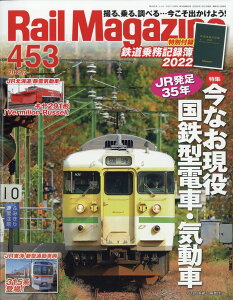
RM MODELS

j train

とれいん

鉄道模型趣味

N

旅と鉄道

楽天トラベルで旅に出よう

鉄道関連書籍リンク
時刻表最新号
JTB時刻表

JR時刻表

鉄道雑誌最新号
鉄道ファン

鉄道ジャーナル

鉄道ピクトリアル

鉄道ダイヤ情報

Rail Magazine

RM MODELS

j train

とれいん

鉄道模型趣味

N

旅と鉄道

楽天トラベルで旅に出よう
コメント新着
テーマ: 鉄道(23078)
カテゴリ: 鉄道ミニエッセイ
6月19日、JRで最後となる国鉄特急色の485系、JR東日本仙台車両センター所属のセンA-1・A-2編成が引退した。
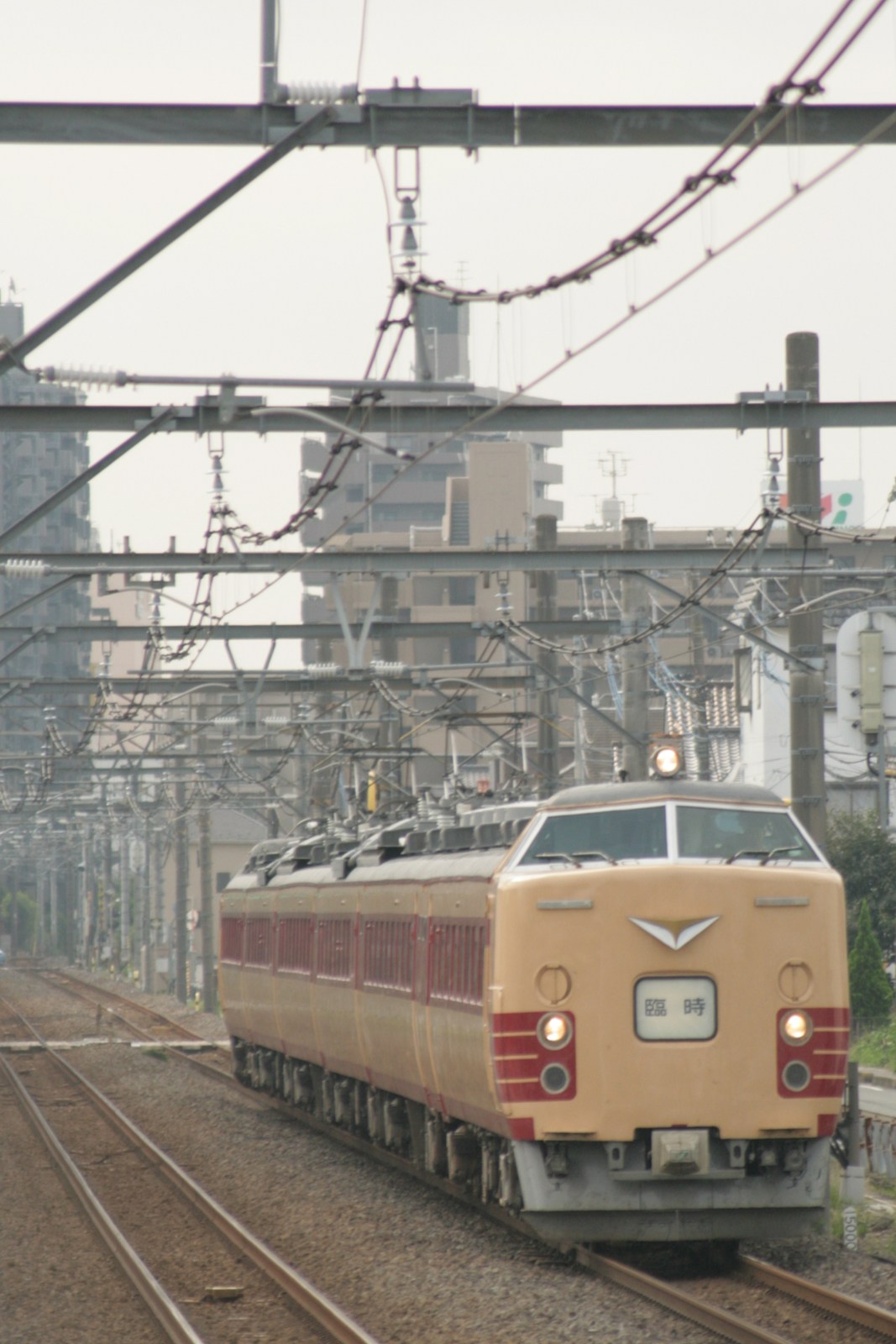
日本の鉄道の一時代を築いた名車両、国鉄485系電車がJRの特急列車から引退したのが去る2016(平成28)年3月21日のことであった。それから3ヶ月、クリーム色(クリーム4号)と赤色(赤2号)の組み合わせの国鉄特急色の編成が営業運転から姿を消した。
485系は1968(昭和43)年に登場した国鉄を代表する特急型電車。1958(昭和33)年に登場した国鉄初の特急型電車で、「こだま形」の愛称で親しまれた151系電車を基本とする設計で、直流・50Hz交流・60Hz交流に対応した、電化された国鉄線を全て走ることができる万能型車両だった。
北は北海道の「いしかり」から南は九州の「有明」「にちりん」「きりしま」まで、幅広く活躍した。485系の礎を築いた481系電車・483系電車、そしてEF63形電気機関車との連結が可能な、かつての国鉄・JR最大の勾配だった碓氷峠越えに対応した489系電車を併せて、以下「485系一族」と称する。485系一族は1964(昭和39)年から1979(昭和54)年にかけて1,453両が製造された。
先頭車両となるクハ481形およびクハ489形の前面で見ると、1964(昭和39)年から1971(昭和46)年にかけて製造された車両が151系に準じたボンネット形、1972(昭和47)年以降に製造された車両が583系に準じた「月光型」スタイルの貫通型もしくは非貫通型(特に非貫通型は鉄道ファンからは「電気釜」の愛称で呼ばれる)となっている。
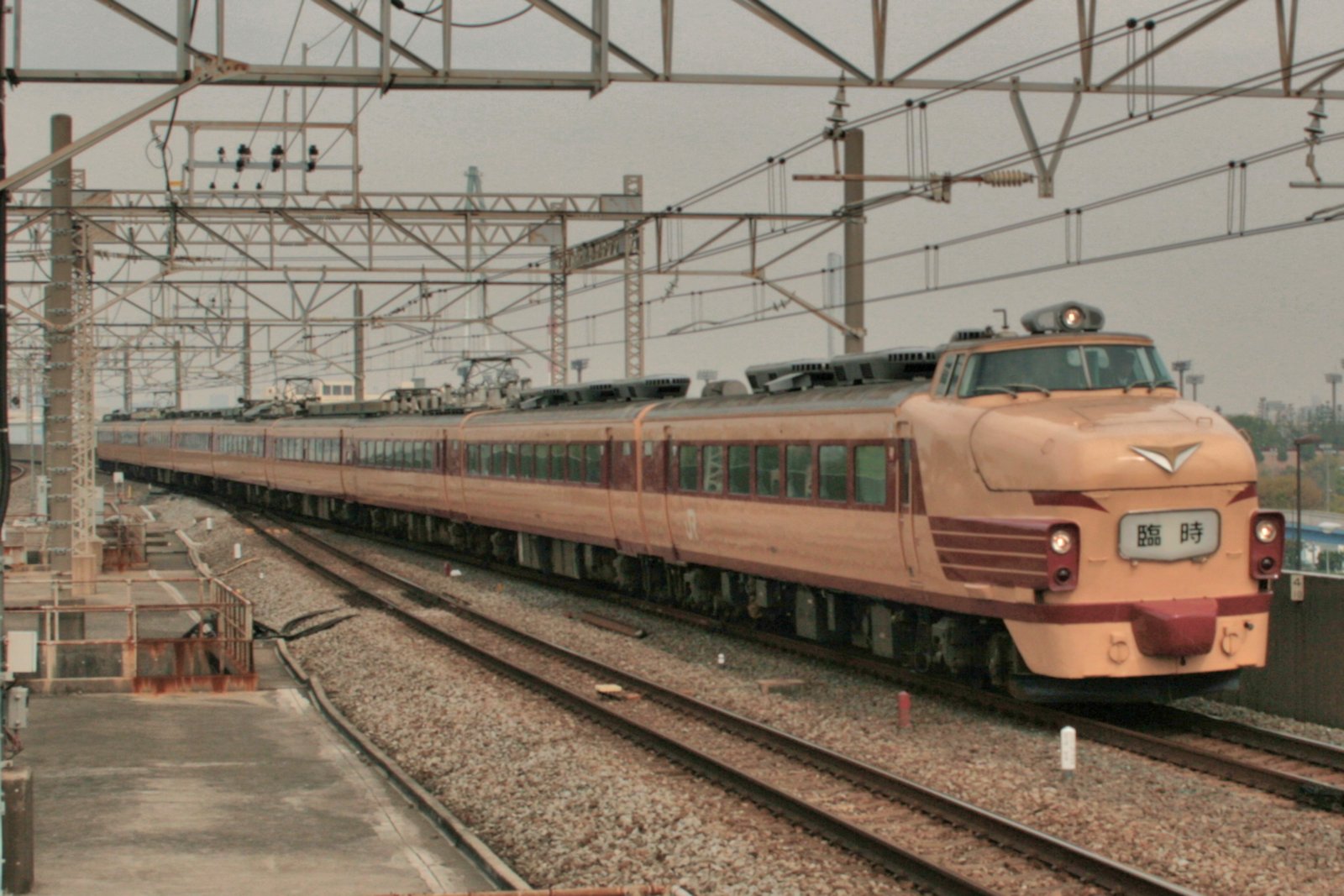
ボンネット型のクハ489形を組み込んだ489系 long-nosed ("bonnet style") 489 Series
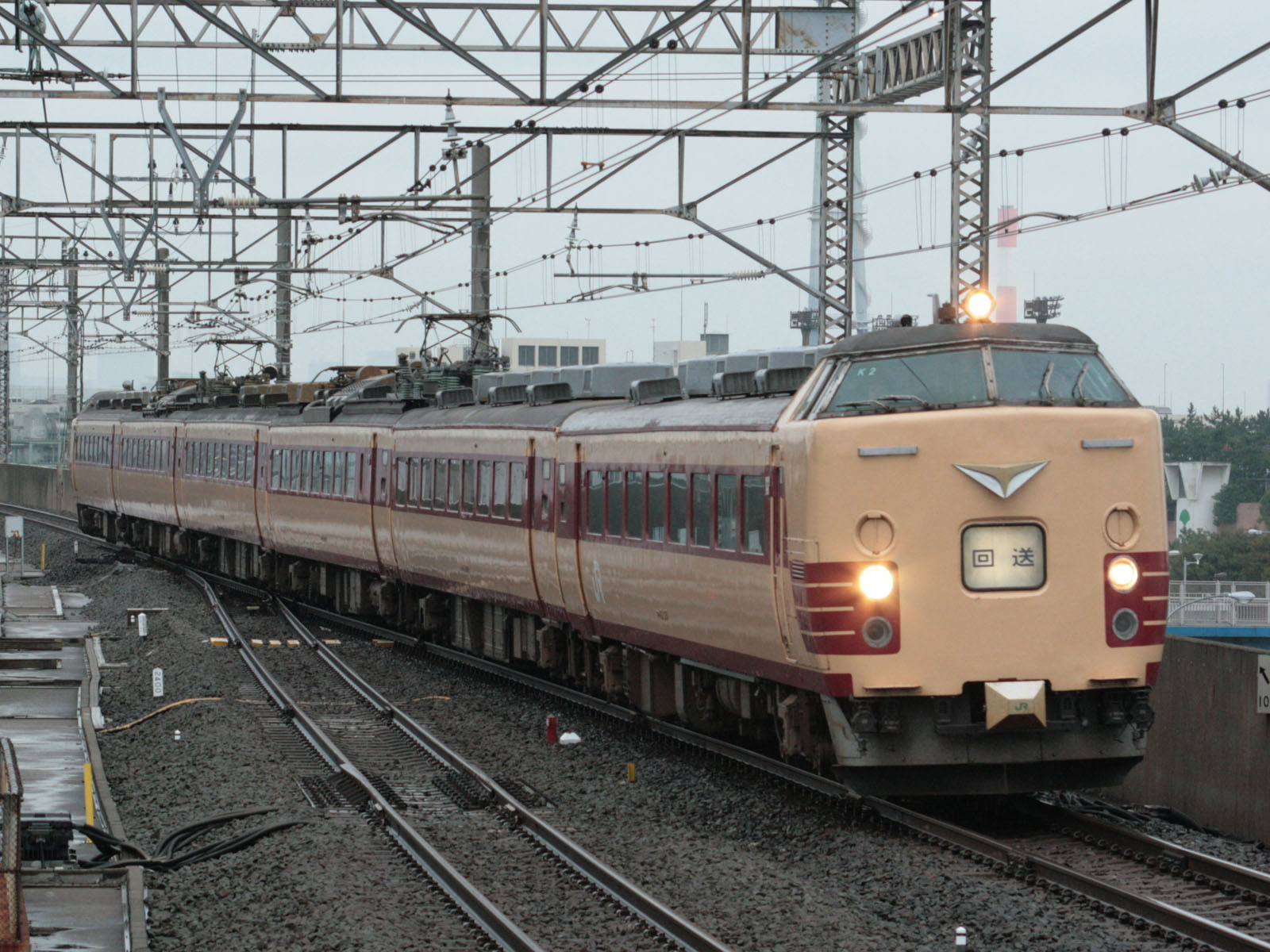
非貫通型(電気釜)のクハ481形・クロハ481形を組み込んだ485系 Non-penetration ("rice cooker") style 485 Series
485系一族の歴史は、大阪駅~富山駅間を結んだ特急「雷鳥」、および名古屋駅~富山駅間を結んだ特急「しらさぎ」用に製造された481系電車にまで遡る。481系は1964(昭和39)年12月25日に登場した、直流と60Hz交流に対応した車両で、向日町運転所(現在の吹田総合車両所京都支所)に配属された。翌1965(昭和40)年10月1日には上野駅~仙台駅間の「ひばり」用の483系電車が、直流と50Hz交流に対応した車両として登場、仙台運転所(現在の仙台車両センター)に配属された。
483系のデビューと同日の1965(昭和40)年10月1日、向日町運転所所属の481系が名古屋駅~熊本駅間の特急「つばめ」、新大阪駅~博多駅の特急「はと」としても運行されることとなった。この時から、向日町を出庫し、まずは大阪駅へと向かい、大阪駅~富山駅の「雷鳥」運用、富山駅~名古屋駅の「しらさぎ」運用をこなして名古屋駅で一夜を明かし、翌日に名古屋駅~熊本駅の「つばめ」運用を連続でこなすようになった。これが後の485系一族の広範囲な運用へと発展していく。
中でも485系のすべての電気に対応した設計を発揮した列車と言える存在が、大阪駅~青森駅間、東海道本線・湖西線・北陸本線(現在のIRいしかわ鉄道線・あいの風とやま鉄道線・えちごトキめき鉄道日本海ひすいラインを含む)・信越本線・白新線・羽越本線・奥羽本線の各線、実に1,040kmを走破した「白鳥」であろう。それまでキハ80系による気動車列車として運行されてきたが、「日本海縦貫線」と総称される前述の各線の電化により、1972(昭和47)年10月2日より485系で運行され、2001(平成13)年3月2日まで運行された「白鳥」は、485系が起用された列車としてはもちろんのこと、歴代の国鉄・JRの昼行特急列車としても最長距離を誇る。
485系はすべての電化区間を走れる特急型電車として誕生したものの、485系一族が主役の時代はそう長くは続かなかった。 東北・北陸方面への列車では引き続き活躍を続けていたが、新幹線が岡山駅、さらには博多駅へと延伸していくにつれて、新大阪駅・大阪駅~九州方面への特急列車が減らされ、活躍の場が次第に縮小されていく。特に1975(昭和50)年の山陽新幹線博多駅開業により、東海道本線・山陽本線系統の長距離特急列車が全廃され、小倉駅または博多駅で新幹線と接続する「有明」「にちりん」といった九州内の特急列車へと活躍の場を追いやられる格好となった。
山陽新幹線博多駅開業に次ぐ、485系一族にとっての大きな転機となった出来事が、1982(昭和57)年の東北新幹線大宮駅~盛岡駅間と上越新幹線大宮駅~新潟駅間の開業、そしてその3年後の1985(昭和60)年の両新幹線の上野駅への延伸である。これまで東京駅から西へ伸びていた新幹線だったが、1965(昭和40)年の「ひばり」以来485系一族が長距離輸送の主力の座にあった、上野駅から北へと向かう新幹線が開通したのである。これにより483系デビュー時から長年主役の座にあった「はつかり」「ひばり」「いなほ」などの上野駅から東北各地を結ぶ特急列車の廃止や運行区間の短縮が実施され、東海道本線・山陽本線に続いて活躍の場が縮小された。具体的には「ひばり」「やまびこ」「やまばと」が廃止され、「はつかり」が上野駅~青森駅間から盛岡駅~青森駅間に、「いなほ」が上野駅~秋田駅・青森駅から新潟駅~酒田駅・秋田駅・青森駅間に短縮されたなどである。また長距離を走る特急列車の象徴と言える存在だった食堂車(サシ481形)を連結する列車がなくなり、他形式に改造された車両を除いて1987(昭和62)年までにサシ481形は全廃された。
国鉄が民営化された1987(昭和62)年以降も生き残った485系一族は、JR北海道・東日本・西日本・九州へと引き継がれ、車体塗装を塗り替えられたり、内装をリニューアルされたりした車両も登場した。JR北海道へは編成単位で引き継がれることはなかったが、引き継がれた車両のうちサシ481形1両は、寝台特急「北斗星」用の24系客車に改造・編入され、スシ24形と改名した。しかし1990年代に入ると、485系一族は新造から20~30年が経過した車両が多数発生し、JR各社は新型特急電車を投入し、順次485系を置き換えていくこととなる。
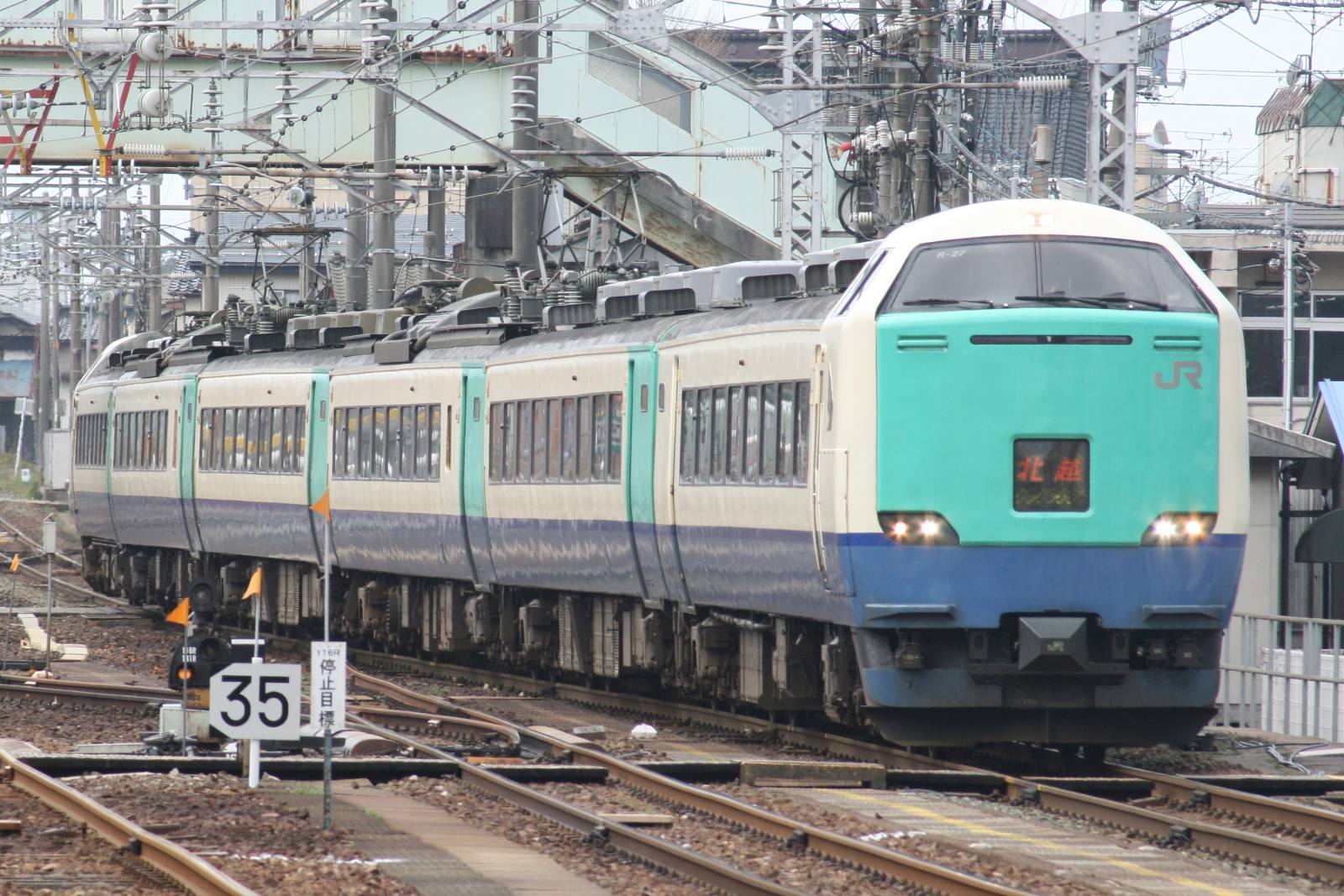
新潟車両センター所属の485系リニューアル車(3000番台) Refurbished 485 Series belonging to Niigata Railyard
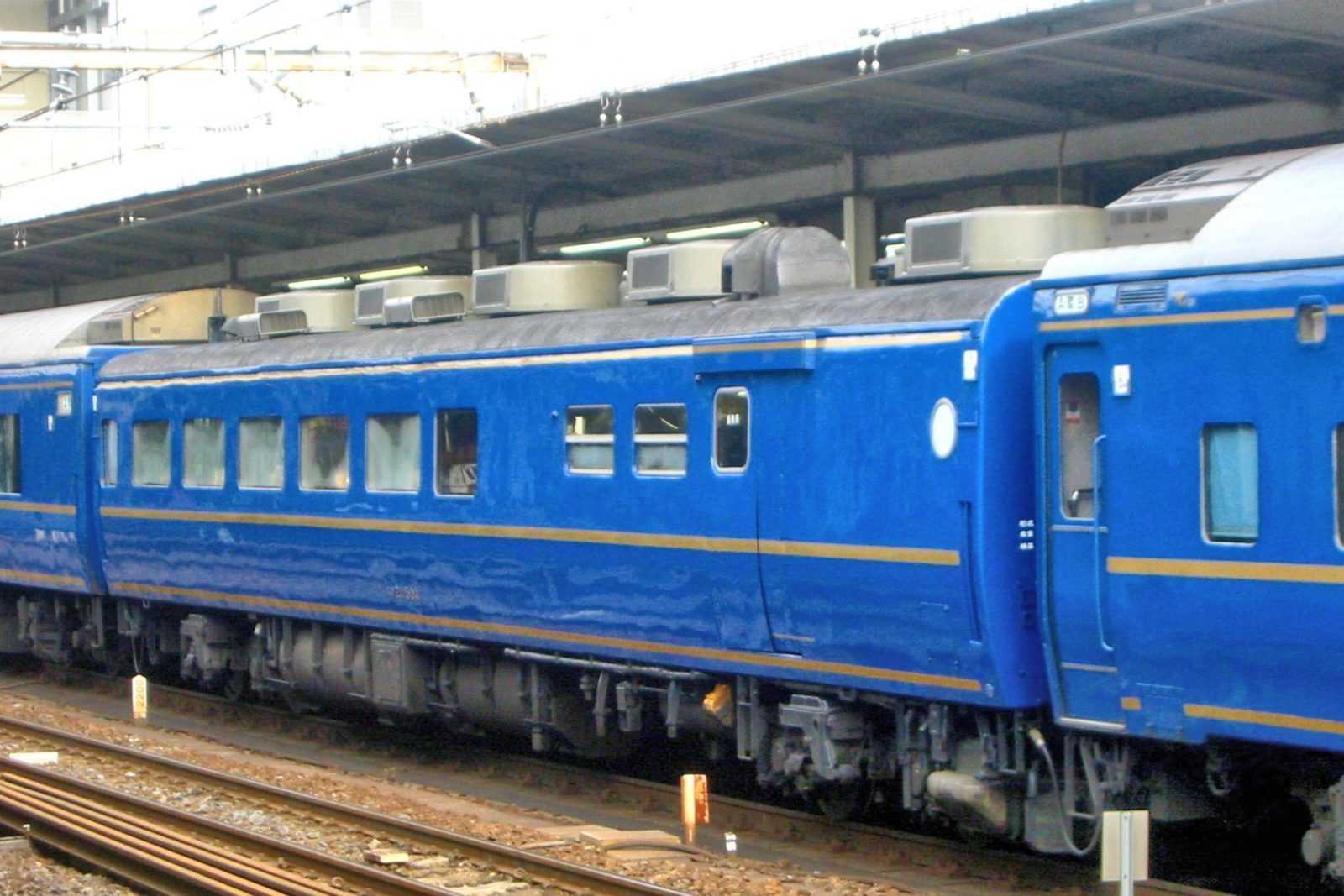
サシ481形の改造車 24系客車「北斗星」用編成の食堂車スシ24形 Sushi 24 dining carriage of 24 Series sleeper passenger carriage for "Hokutosei" converted from Sashi 481 of 485 Series
21世紀を迎えてからも、485系一族を使用した列車の減便が目立ち、最初の大きな変化は2001(平成13)年3月のダイヤ改正である。前述の通り、国鉄・JRの最長の走行距離を誇った昼行特急列車「白鳥」が運行を終了したと同時に、「雷鳥」も新潟駅発着がなくなり大阪駅~金沢駅間の運行に短縮された。その一方で、2002(平成14)年に八戸駅~函館駅(のちに新青森駅~函館駅へ変更)間の「白鳥」、八戸駅~弘前駅(のちに新青森駅~弘前駅に短縮)間の「つがる」が、2006(平成18)年には新宿駅~東武日光駅間の「日光」、新宿駅~鬼怒川温泉駅間の「きぬがわ」が、485系を使用した列車としてそれぞれ新設された。

小山車両センター所属だった「日光」・「きぬがわ」用の485系 Refurbished 485 Series for "Nikko" and "Kinugawa" belonging to Oyama Railyard.
2010(平成22)年にはデビュー当時からのボンネット型の前面を持つ489系で運行された急行「能登」が運行を終了し、489系の定期運行がゼロとなり、ボンネット型の485系一族が姿を消した。
そして、485系の引退を強く匂わせる出来事が2011(平成23)年に起こる。この年の3月11日、485系一族の祖、481系が最初に投入された「雷鳥」がこの日を最後に廃止されたのである。これによりJR西日本所属の車両の定期運行が終了した。さらに翌日に九州新幹線の全線開通を控えたJR九州管内でも485系による定期列車がこの日を最後になくなった。そして同年、4月23日に「つがる」もE751系に、6月4日に「日光」「きぬがわ」も「成田エクスプレス」から転用された253系に置き換えられた。これによって485系の定期運行はJR東日本所属の車両による「白鳥」「いなほ」「北越」のみとなった。
しかしこれらの運用も、485系の老朽化が目立ってきたことや新幹線の延伸によって、新型車両への置き換え、もしくは廃止となる。2013(平成25)年から2014(平成26)年にかけて、「いなほ」に「フレッシュひたち」(現在の「ときわ」)から転用されたE653系が投入され、485系が同列車から引退したことに続いて、2015(平成27)年3月の北陸新幹線長野駅~金沢駅間延伸に伴って「北越」が、2016(平成28)年3月の北海道新幹線新青森駅~新函館北斗駅間開業に伴って「白鳥」が廃止され、485系による特急列車運用がゼロとなった。
引退した車両のうち485系が埼玉県・大宮の鉄道博物館(クハ481形 ボンネット型・モハ484形)、新潟県・新津の新潟市新津鉄道資料館(クハ481形 非貫通型)、福岡県・門司の九州鉄道記念館(クハ481形 ボンネット型)に、489系が京都府・梅小路の京都鉄道博物館(クハ489形 ボンネット型)、石川県・小松の土居原ボンネット広場(クハ489形 ボンネット型)にそれぞれ保存・展示されており、その姿を拝むことができる。
終わりに、国鉄・JRの特急列車を52年間の長きに渡って支えてきた485系一族の物語は、今後も語り継がれることであろう。
On June 19th, 2016, 485 Series Sen A-1・A-2 set, which had a pail-orange-and-red-coloured body, traditional colour of the carriages for limited express train in Japan National Railway (JNR) period, and last one in service, retired. Three months had passed since all 485 Series sets' retirement from regular operations of limited express trains on JR Lines.
485 Series debuted in 1968 and was designed as the carriage capable of the operations on all electrified JNR lines, available to DC, 50Hz AC, and 60Hz AC, based on 151 Series, the first electric carriage for limited express train in Japan known as "Kodama" between Tokyo and Osaka or Kobe before opening Shinkansen. Fully using its specification, the carriages used to run all over Japan, the northernmost was "Ishikari" in Hokkaido and the southernmost was "Kirishima" in Kyushu, and created the golden age of limited express trains after World War Two.
485 Series family, including 481 Series, designed for DC and 60Hz AC electrified lines and built the basement of 485 Series, 483 Series, done for DC and 50Hz AC, and 489 Series, improved model available to coupling with Class EF63 electric locomotive for going up and down steep slope on Shinetsu Main Line, were totally built 1,453 carriages between 1964 and 1979.
The history of 485 Series family started when 481 Series debuted as "Raicho" limited express between Osaka Station and Toyama Station and "Shirasagi" limited express between Nagoya Station and Toyama Station on December 25th, 1964. In the following year, 483 Series also debuted as "Hibari" limited express between Ueno Station and Sendai Station.
On October 1st, 1965, the same day as 483 Series' debut, 481 Series also started to operate as "Tsubame" limited express between Nagoya Station and Kumamoto Station and "Hato" limited express between Shin-osaka Station and Hakata Station. Since that, a 481 Series set continuously operated. One day it first ran as "Raicho" from Osaka, next as "Shirasagi" from Toyama. Passing a night at Nagoya Station, it went to Kumamoto Station as "Tsubame". These operations lead pervasive use of 485 Series family.
As the area 481 Series ran spread, JNR faced the problem of the electric power supply, the difference of the frequency between east Japan (50Hz) and West Japan (60Hz) bounded by Fujikawa-Itoigawa Line.To prepare for the train running through both 50Hz and 60Hz AC-electrified lines and mutual transfer between the railyard on the different frequency sections, 485 Series was designed and debuted on October 1st, 1968.
It was said that the train made the best use of 485 Series' specification capable of all electrified sections was "Hakucho" limited express between Osaka Station and Aomori Station via Tokaido Main Line, Kosei Line, Hokuriku Main Line (including present IR Ishikawa Railway, Ainokaze Toyama Railway, and Echigo Tokimeki Railway Nihonkai Hisui Lines), Shinetsu Main Line, Hakushin Line, Uetsu Main Line, and Ouu Main Lines, which was the longest (1,040km/646.226mi) distance among successive JNR and JR limited express trains until 2001. On that time, Osaka Station on Tokaido Line and Nagahara Station on Kosei Line and Itoigawa Station on Hokuriku Main Line and Murakami Station on Uetsu Main Line were DC-electrified, Nagahara and Itoigawa Station on Hokuriku Main Line was 60Hz AC-electrified, and between Murakami and Aomori on Ouu Main Line was 50Hz AC-electrified.
However, the golden age of 485 Series family didn't last so long. As Shinkansen was extended to the westward and northward, the limited express trains overlapped with Shinkansen gradually decreased. At first when Shinkansen was extended to Hakata Station in 1975, all of limited express trains operated by 485 Series between Shin-osaka, Osaka, or Okayama Station toward Kyushu area ended to run and the carriages transferred to those only on Kyushu such as "Ariake" limited express (Moji Station or Hakata Station - Nishi-kagoshima (present Kagoshima-chuo Station) via Kagoshima Main Line (including present Hisatsu Orange Railway Line)) and "Nichirin" limited express (Hakata - Nishi-kagoshima via Nippo Main Line). Following that, when Tohoku Shinkansen between Omiya Station and Morioka Station and Joetsu Shinkansen between Omiya Station and Niigata Station opened in 1982 and they were extended to Ueno Station in 1985, almost all of limited express trains on Tohoku Main Line from/to Ueno Station ended or shortened its service. For example, "Hibari", "Yamabiko" (Ueno - Morioka), and "Yamabato" (Ueno - Yamagata via Ouu Main Line) were abolished, and "Hatsukari" (Ueno - Aomori) was shortened between Morioka and Aomori and "Inaho" (Ueno - Akita or Aomori via Takasaki, Joetsu, Shinetsu, Uetsu, and Ouu Lines) was between Niigata to Sakata, Akita, or Aomori via Hakushin, Uetsu, and Ouu Lines. At the same time, the daytime limited express trains coupling the dining carriage (Sashi 481) completely disappeared and the dining carriages were scrapped except the ones converted to the other use until 1987.
After the privatization of JNR in 1987, 485 Series family were inherited to JR Hokkaido, JR East, JR West, and JR Kyushu and kept in service as JNR period. The dining carriage inherited to JR Hokkaido was converted to that (Sushi 24) for "Hokutosei" sleeper train (Ueno - Sapporo). However, 20 or 30 years had passed since many of 485 Series family carriages built in the 1990s and they started to be replaced by newly-made models.
After entering the 21st century, the number of limited express trains by 485 Series family kept being decreased. In 2001, As already stated, "Hakucho" finished its service and "Raicho" shortened to between Osaka and Kanazawa. On the other hand, in 2002 "Hakucho" (Hachinohe - Hakodate) and "Tsugaru" (Hachinohe - Hirosaki), in 2006 "Nikko" (Shinjuku - Tobu-nikko) and "Kinugawa" (Shinjuku - Kinugawa-onsen) started to run by 485 Series.
In 2010, the first long-nosed model of 485 Series family finished its regular operation. The last one was "Noto" overnight express by 489 Series.
In 2011, decisive events to lead the complete retirement happened. On March 11, "Raicho", the first train 485 Series family was introduced, finished its service and all of the ones in Kyushu area retired from regular operation such as "Hyuga" and "Kirishima", both of which were introduced the 787 Series moved from "Relay Tsubame". Following that, the one for "Tsugaru" (Shin-aomori - Hirosaki) was by E751 Series, and on June 4th the one for "Nikko", and "Kinugawa" were replaced by 253 Series.
The last three trains by 485 Series were "Inaho", "Hokuetsu" (Kanazawa - Niigata), and "Hakucho" (Shin-aomori - Hakodate), but they also finished their service influenced by newly open of Shinkansen or replacement by a new carriage by March, 2016.
Then June 19th, 2016, the last day of the traditional-coloured 485 Series had come. The last traditional-coloured set, Sen A-1・A-2, used to run as "Aizu" special limited express or "Aizu Liner" rapid train on Banetsu West Line. Though it once changed its body colour to the red with Akabeko (traditional toy of the red cow) illustration and its interior was refurbished, it was repainted to the traditional body colour in 2011. Some railfans regard the retirement of this traditional colour of the carriages for the limited express train since 151 Series' debut in 1958 as the end of a certain era on the Japanese railway history.
Several carriages in the traditional colour are preserving in railway museums and a park, such as The Railway Museum (long-nosed Kuha 481 and Moha 484), Niigata City Niitsu Railway Museum (non-penetration style Kuha 481), Kyushu Railway History Museum (long-nosed Kuha 481), Kyoto Railway Museum (long-nosed Kuha 489), and Doihara Bonnet Place in Ishikawa Prefecture (long-nosed Kuha 489).
Finally, the 52-year history of 485 Series family might be transmitted by word of mouth.
参考文献 Refernce

日本の鉄道の一時代を築いた名車両、国鉄485系電車がJRの特急列車から引退したのが去る2016(平成28)年3月21日のことであった。それから3ヶ月、クリーム色(クリーム4号)と赤色(赤2号)の組み合わせの国鉄特急色の編成が営業運転から姿を消した。
485系は1968(昭和43)年に登場した国鉄を代表する特急型電車。1958(昭和33)年に登場した国鉄初の特急型電車で、「こだま形」の愛称で親しまれた151系電車を基本とする設計で、直流・50Hz交流・60Hz交流に対応した、電化された国鉄線を全て走ることができる万能型車両だった。
北は北海道の「いしかり」から南は九州の「有明」「にちりん」「きりしま」まで、幅広く活躍した。485系の礎を築いた481系電車・483系電車、そしてEF63形電気機関車との連結が可能な、かつての国鉄・JR最大の勾配だった碓氷峠越えに対応した489系電車を併せて、以下「485系一族」と称する。485系一族は1964(昭和39)年から1979(昭和54)年にかけて1,453両が製造された。
先頭車両となるクハ481形およびクハ489形の前面で見ると、1964(昭和39)年から1971(昭和46)年にかけて製造された車両が151系に準じたボンネット形、1972(昭和47)年以降に製造された車両が583系に準じた「月光型」スタイルの貫通型もしくは非貫通型(特に非貫通型は鉄道ファンからは「電気釜」の愛称で呼ばれる)となっている。

ボンネット型のクハ489形を組み込んだ489系 long-nosed ("bonnet style") 489 Series

非貫通型(電気釜)のクハ481形・クロハ481形を組み込んだ485系 Non-penetration ("rice cooker") style 485 Series
485系一族の歴史は、大阪駅~富山駅間を結んだ特急「雷鳥」、および名古屋駅~富山駅間を結んだ特急「しらさぎ」用に製造された481系電車にまで遡る。481系は1964(昭和39)年12月25日に登場した、直流と60Hz交流に対応した車両で、向日町運転所(現在の吹田総合車両所京都支所)に配属された。翌1965(昭和40)年10月1日には上野駅~仙台駅間の「ひばり」用の483系電車が、直流と50Hz交流に対応した車両として登場、仙台運転所(現在の仙台車両センター)に配属された。
483系のデビューと同日の1965(昭和40)年10月1日、向日町運転所所属の481系が名古屋駅~熊本駅間の特急「つばめ」、新大阪駅~博多駅の特急「はと」としても運行されることとなった。この時から、向日町を出庫し、まずは大阪駅へと向かい、大阪駅~富山駅の「雷鳥」運用、富山駅~名古屋駅の「しらさぎ」運用をこなして名古屋駅で一夜を明かし、翌日に名古屋駅~熊本駅の「つばめ」運用を連続でこなすようになった。これが後の485系一族の広範囲な運用へと発展していく。
中でも485系のすべての電気に対応した設計を発揮した列車と言える存在が、大阪駅~青森駅間、東海道本線・湖西線・北陸本線(現在のIRいしかわ鉄道線・あいの風とやま鉄道線・えちごトキめき鉄道日本海ひすいラインを含む)・信越本線・白新線・羽越本線・奥羽本線の各線、実に1,040kmを走破した「白鳥」であろう。それまでキハ80系による気動車列車として運行されてきたが、「日本海縦貫線」と総称される前述の各線の電化により、1972(昭和47)年10月2日より485系で運行され、2001(平成13)年3月2日まで運行された「白鳥」は、485系が起用された列車としてはもちろんのこと、歴代の国鉄・JRの昼行特急列車としても最長距離を誇る。
485系はすべての電化区間を走れる特急型電車として誕生したものの、485系一族が主役の時代はそう長くは続かなかった。 東北・北陸方面への列車では引き続き活躍を続けていたが、新幹線が岡山駅、さらには博多駅へと延伸していくにつれて、新大阪駅・大阪駅~九州方面への特急列車が減らされ、活躍の場が次第に縮小されていく。特に1975(昭和50)年の山陽新幹線博多駅開業により、東海道本線・山陽本線系統の長距離特急列車が全廃され、小倉駅または博多駅で新幹線と接続する「有明」「にちりん」といった九州内の特急列車へと活躍の場を追いやられる格好となった。
山陽新幹線博多駅開業に次ぐ、485系一族にとっての大きな転機となった出来事が、1982(昭和57)年の東北新幹線大宮駅~盛岡駅間と上越新幹線大宮駅~新潟駅間の開業、そしてその3年後の1985(昭和60)年の両新幹線の上野駅への延伸である。これまで東京駅から西へ伸びていた新幹線だったが、1965(昭和40)年の「ひばり」以来485系一族が長距離輸送の主力の座にあった、上野駅から北へと向かう新幹線が開通したのである。これにより483系デビュー時から長年主役の座にあった「はつかり」「ひばり」「いなほ」などの上野駅から東北各地を結ぶ特急列車の廃止や運行区間の短縮が実施され、東海道本線・山陽本線に続いて活躍の場が縮小された。具体的には「ひばり」「やまびこ」「やまばと」が廃止され、「はつかり」が上野駅~青森駅間から盛岡駅~青森駅間に、「いなほ」が上野駅~秋田駅・青森駅から新潟駅~酒田駅・秋田駅・青森駅間に短縮されたなどである。また長距離を走る特急列車の象徴と言える存在だった食堂車(サシ481形)を連結する列車がなくなり、他形式に改造された車両を除いて1987(昭和62)年までにサシ481形は全廃された。
国鉄が民営化された1987(昭和62)年以降も生き残った485系一族は、JR北海道・東日本・西日本・九州へと引き継がれ、車体塗装を塗り替えられたり、内装をリニューアルされたりした車両も登場した。JR北海道へは編成単位で引き継がれることはなかったが、引き継がれた車両のうちサシ481形1両は、寝台特急「北斗星」用の24系客車に改造・編入され、スシ24形と改名した。しかし1990年代に入ると、485系一族は新造から20~30年が経過した車両が多数発生し、JR各社は新型特急電車を投入し、順次485系を置き換えていくこととなる。

新潟車両センター所属の485系リニューアル車(3000番台) Refurbished 485 Series belonging to Niigata Railyard

サシ481形の改造車 24系客車「北斗星」用編成の食堂車スシ24形 Sushi 24 dining carriage of 24 Series sleeper passenger carriage for "Hokutosei" converted from Sashi 481 of 485 Series
21世紀を迎えてからも、485系一族を使用した列車の減便が目立ち、最初の大きな変化は2001(平成13)年3月のダイヤ改正である。前述の通り、国鉄・JRの最長の走行距離を誇った昼行特急列車「白鳥」が運行を終了したと同時に、「雷鳥」も新潟駅発着がなくなり大阪駅~金沢駅間の運行に短縮された。その一方で、2002(平成14)年に八戸駅~函館駅(のちに新青森駅~函館駅へ変更)間の「白鳥」、八戸駅~弘前駅(のちに新青森駅~弘前駅に短縮)間の「つがる」が、2006(平成18)年には新宿駅~東武日光駅間の「日光」、新宿駅~鬼怒川温泉駅間の「きぬがわ」が、485系を使用した列車としてそれぞれ新設された。

小山車両センター所属だった「日光」・「きぬがわ」用の485系 Refurbished 485 Series for "Nikko" and "Kinugawa" belonging to Oyama Railyard.
2010(平成22)年にはデビュー当時からのボンネット型の前面を持つ489系で運行された急行「能登」が運行を終了し、489系の定期運行がゼロとなり、ボンネット型の485系一族が姿を消した。
そして、485系の引退を強く匂わせる出来事が2011(平成23)年に起こる。この年の3月11日、485系一族の祖、481系が最初に投入された「雷鳥」がこの日を最後に廃止されたのである。これによりJR西日本所属の車両の定期運行が終了した。さらに翌日に九州新幹線の全線開通を控えたJR九州管内でも485系による定期列車がこの日を最後になくなった。そして同年、4月23日に「つがる」もE751系に、6月4日に「日光」「きぬがわ」も「成田エクスプレス」から転用された253系に置き換えられた。これによって485系の定期運行はJR東日本所属の車両による「白鳥」「いなほ」「北越」のみとなった。
しかしこれらの運用も、485系の老朽化が目立ってきたことや新幹線の延伸によって、新型車両への置き換え、もしくは廃止となる。2013(平成25)年から2014(平成26)年にかけて、「いなほ」に「フレッシュひたち」(現在の「ときわ」)から転用されたE653系が投入され、485系が同列車から引退したことに続いて、2015(平成27)年3月の北陸新幹線長野駅~金沢駅間延伸に伴って「北越」が、2016(平成28)年3月の北海道新幹線新青森駅~新函館北斗駅間開業に伴って「白鳥」が廃止され、485系による特急列車運用がゼロとなった。
引退した車両のうち485系が埼玉県・大宮の鉄道博物館(クハ481形 ボンネット型・モハ484形)、新潟県・新津の新潟市新津鉄道資料館(クハ481形 非貫通型)、福岡県・門司の九州鉄道記念館(クハ481形 ボンネット型)に、489系が京都府・梅小路の京都鉄道博物館(クハ489形 ボンネット型)、石川県・小松の土居原ボンネット広場(クハ489形 ボンネット型)にそれぞれ保存・展示されており、その姿を拝むことができる。
終わりに、国鉄・JRの特急列車を52年間の長きに渡って支えてきた485系一族の物語は、今後も語り継がれることであろう。
On June 19th, 2016, 485 Series Sen A-1・A-2 set, which had a pail-orange-and-red-coloured body, traditional colour of the carriages for limited express train in Japan National Railway (JNR) period, and last one in service, retired. Three months had passed since all 485 Series sets' retirement from regular operations of limited express trains on JR Lines.
485 Series debuted in 1968 and was designed as the carriage capable of the operations on all electrified JNR lines, available to DC, 50Hz AC, and 60Hz AC, based on 151 Series, the first electric carriage for limited express train in Japan known as "Kodama" between Tokyo and Osaka or Kobe before opening Shinkansen. Fully using its specification, the carriages used to run all over Japan, the northernmost was "Ishikari" in Hokkaido and the southernmost was "Kirishima" in Kyushu, and created the golden age of limited express trains after World War Two.
485 Series family, including 481 Series, designed for DC and 60Hz AC electrified lines and built the basement of 485 Series, 483 Series, done for DC and 50Hz AC, and 489 Series, improved model available to coupling with Class EF63 electric locomotive for going up and down steep slope on Shinetsu Main Line, were totally built 1,453 carriages between 1964 and 1979.
The history of 485 Series family started when 481 Series debuted as "Raicho" limited express between Osaka Station and Toyama Station and "Shirasagi" limited express between Nagoya Station and Toyama Station on December 25th, 1964. In the following year, 483 Series also debuted as "Hibari" limited express between Ueno Station and Sendai Station.
On October 1st, 1965, the same day as 483 Series' debut, 481 Series also started to operate as "Tsubame" limited express between Nagoya Station and Kumamoto Station and "Hato" limited express between Shin-osaka Station and Hakata Station. Since that, a 481 Series set continuously operated. One day it first ran as "Raicho" from Osaka, next as "Shirasagi" from Toyama. Passing a night at Nagoya Station, it went to Kumamoto Station as "Tsubame". These operations lead pervasive use of 485 Series family.
As the area 481 Series ran spread, JNR faced the problem of the electric power supply, the difference of the frequency between east Japan (50Hz) and West Japan (60Hz) bounded by Fujikawa-Itoigawa Line.To prepare for the train running through both 50Hz and 60Hz AC-electrified lines and mutual transfer between the railyard on the different frequency sections, 485 Series was designed and debuted on October 1st, 1968.
It was said that the train made the best use of 485 Series' specification capable of all electrified sections was "Hakucho" limited express between Osaka Station and Aomori Station via Tokaido Main Line, Kosei Line, Hokuriku Main Line (including present IR Ishikawa Railway, Ainokaze Toyama Railway, and Echigo Tokimeki Railway Nihonkai Hisui Lines), Shinetsu Main Line, Hakushin Line, Uetsu Main Line, and Ouu Main Lines, which was the longest (1,040km/646.226mi) distance among successive JNR and JR limited express trains until 2001. On that time, Osaka Station on Tokaido Line and Nagahara Station on Kosei Line and Itoigawa Station on Hokuriku Main Line and Murakami Station on Uetsu Main Line were DC-electrified, Nagahara and Itoigawa Station on Hokuriku Main Line was 60Hz AC-electrified, and between Murakami and Aomori on Ouu Main Line was 50Hz AC-electrified.
However, the golden age of 485 Series family didn't last so long. As Shinkansen was extended to the westward and northward, the limited express trains overlapped with Shinkansen gradually decreased. At first when Shinkansen was extended to Hakata Station in 1975, all of limited express trains operated by 485 Series between Shin-osaka, Osaka, or Okayama Station toward Kyushu area ended to run and the carriages transferred to those only on Kyushu such as "Ariake" limited express (Moji Station or Hakata Station - Nishi-kagoshima (present Kagoshima-chuo Station) via Kagoshima Main Line (including present Hisatsu Orange Railway Line)) and "Nichirin" limited express (Hakata - Nishi-kagoshima via Nippo Main Line). Following that, when Tohoku Shinkansen between Omiya Station and Morioka Station and Joetsu Shinkansen between Omiya Station and Niigata Station opened in 1982 and they were extended to Ueno Station in 1985, almost all of limited express trains on Tohoku Main Line from/to Ueno Station ended or shortened its service. For example, "Hibari", "Yamabiko" (Ueno - Morioka), and "Yamabato" (Ueno - Yamagata via Ouu Main Line) were abolished, and "Hatsukari" (Ueno - Aomori) was shortened between Morioka and Aomori and "Inaho" (Ueno - Akita or Aomori via Takasaki, Joetsu, Shinetsu, Uetsu, and Ouu Lines) was between Niigata to Sakata, Akita, or Aomori via Hakushin, Uetsu, and Ouu Lines. At the same time, the daytime limited express trains coupling the dining carriage (Sashi 481) completely disappeared and the dining carriages were scrapped except the ones converted to the other use until 1987.
After the privatization of JNR in 1987, 485 Series family were inherited to JR Hokkaido, JR East, JR West, and JR Kyushu and kept in service as JNR period. The dining carriage inherited to JR Hokkaido was converted to that (Sushi 24) for "Hokutosei" sleeper train (Ueno - Sapporo). However, 20 or 30 years had passed since many of 485 Series family carriages built in the 1990s and they started to be replaced by newly-made models.
After entering the 21st century, the number of limited express trains by 485 Series family kept being decreased. In 2001, As already stated, "Hakucho" finished its service and "Raicho" shortened to between Osaka and Kanazawa. On the other hand, in 2002 "Hakucho" (Hachinohe - Hakodate) and "Tsugaru" (Hachinohe - Hirosaki), in 2006 "Nikko" (Shinjuku - Tobu-nikko) and "Kinugawa" (Shinjuku - Kinugawa-onsen) started to run by 485 Series.
In 2010, the first long-nosed model of 485 Series family finished its regular operation. The last one was "Noto" overnight express by 489 Series.
In 2011, decisive events to lead the complete retirement happened. On March 11, "Raicho", the first train 485 Series family was introduced, finished its service and all of the ones in Kyushu area retired from regular operation such as "Hyuga" and "Kirishima", both of which were introduced the 787 Series moved from "Relay Tsubame". Following that, the one for "Tsugaru" (Shin-aomori - Hirosaki) was by E751 Series, and on June 4th the one for "Nikko", and "Kinugawa" were replaced by 253 Series.
The last three trains by 485 Series were "Inaho", "Hokuetsu" (Kanazawa - Niigata), and "Hakucho" (Shin-aomori - Hakodate), but they also finished their service influenced by newly open of Shinkansen or replacement by a new carriage by March, 2016.
Then June 19th, 2016, the last day of the traditional-coloured 485 Series had come. The last traditional-coloured set, Sen A-1・A-2, used to run as "Aizu" special limited express or "Aizu Liner" rapid train on Banetsu West Line. Though it once changed its body colour to the red with Akabeko (traditional toy of the red cow) illustration and its interior was refurbished, it was repainted to the traditional body colour in 2011. Some railfans regard the retirement of this traditional colour of the carriages for the limited express train since 151 Series' debut in 1958 as the end of a certain era on the Japanese railway history.
Several carriages in the traditional colour are preserving in railway museums and a park, such as The Railway Museum (long-nosed Kuha 481 and Moha 484), Niigata City Niitsu Railway Museum (non-penetration style Kuha 481), Kyushu Railway History Museum (long-nosed Kuha 481), Kyoto Railway Museum (long-nosed Kuha 489), and Doihara Bonnet Place in Ishikawa Prefecture (long-nosed Kuha 489).
Finally, the 52-year history of 485 Series family might be transmitted by word of mouth.
参考文献 Refernce
- 『485系物語』 JTBキャンブックス
- 『鉄道ピクトリアル』 2011年4月号「485・489系電車」 電気車研究会
- 『鉄道ピクトリアル』 2014年11月号「485・489系電車(I)」 電気車研究会
- 『鉄道ピクトリアル』 2014年12月号「485・489系電車(II)」 電気車研究会
お気に入りの記事を「いいね!」で応援しよう
[鉄道ミニエッセイ] カテゴリの最新記事
-
683系「サンダーバード」に乗る Nov 23, 2021
-
"地下鉄のお嬢ちゃん"ステッカーの魅力 Sep 7, 2019
-
東急に「鉄道むすめ」がいない理由は「な… Aug 4, 2019
【毎日開催】
15記事にいいね!で1ポイント
10秒滞在
いいね!
--
/
--
© Rakuten Group, Inc.








